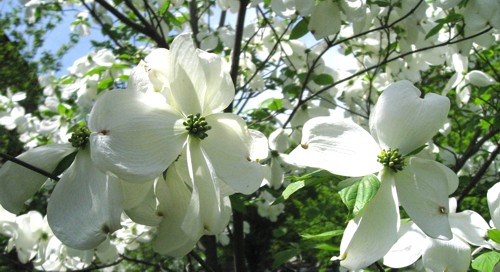Chinese Dogwood Tree [Cornus kousa]

I saw this tree today at Nyman's Gardens, Handcross, Sussex and thought it was beautiful. H/T to University of Arkansas for information on this wonderful plant.
'The Chinese dogwood comes into bloom in mid-May and lasting until early June. It is a 20-foot tall, twiggy, round-headed tree that is small enough to be accommodated in even the most crowded garden. Its flowers appear three weeks after those of the native dogwood.
The blooms are pointed on the end instead of bobbed off like our native dogwood, giving the appearance of white four-pointed stars against the dense green background foliage. The individual petals -- actually modified leaves called bracts -- are usually 2- to 2 1/2 inches long and about one-third as wide. They begin as a beautiful light green and gradually change to bright white as the flowers open.
In the autumn, the Chinese dogwood produces round ping-pong size clusters of red fruit on drooping peduncles that add another dimension of beauty to the tree. Autumn color is usually excellent, in shades of red to scarlet, and persists for two to three weeks.
On old trees, the bark takes on a wonderful flaking characteristic which, while not as beautiful as some of the crape myrtle selections, is still very attractive. The Chinese dogwood was introduced into cultivation in 1907 by the Arnold Arboretum’s great plant collector, E. H. Wilson (1876-1930).
The best known selection of the Chinese dogwood is a cultivar called "Milky Way," which was introduced by Wayside Gardens when they were still located in Mentor, Ohio. Wayside’s nurserymen grew an assortment of seedlings from as many seed sources as possible and selected 15 trees that produced large bracts and had a precocious flowering habit. This block of trees became the source of scion wood when the tree was introduced in the late 1960's. Because 15 trees were selected instead of one, there will sometimes be variation between trees grown under the name "Milky Way."
The Chinese dogwood is easier to grow than our native dogwood, but it still does best when given a reasonably fertile soil and good drainage. While I have seen it used in the middle of parking lot islands in full sun, it is better sited where it gets some afternoon shade.
It should be watered during dry periods, but otherwise requires no special care. It is not as susceptible to the dogwood borer and, so far at least, has shown good resistance to both dogwood powdery mildew and dogwood anthracnose that have plagued our native trees.
Chinese dogwoods can sometimes be slow to flower. If grown from seed, it is not unusual for trees to take seven to 10 years to reach maturity and become old enough to bloom. Even budded trees, which in theory at least should always bloom, are shy to bloom their first few years. The best way to set good flowering is to avoid over-fertilizing while keeping the plant well watered during the early part of the growing season. Then, after mid July cut back on watering and allow the plant to experience the joys of summer. This more stressful summer experience usually promotes good flower bud set in the autumn.'